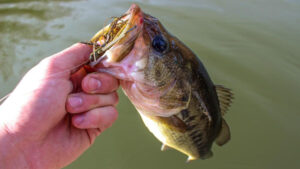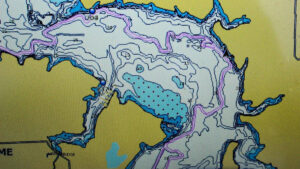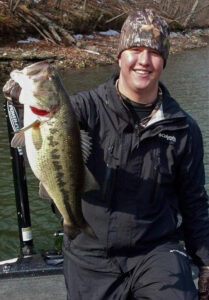The colder shorter days and temperatures around the country, compound cabin fever for most bass anglers. I’ve never been much of an ice-fisherman, so the thin layer of ice that has formed over most of the fisheries in the Midwest more resembles prison bars to guys like me.
You can only change line and clean reels so many times and organizing tackle will keep you entertained for about a day. I get a little chippy this time of year with friends and family as I have no escape to my lack-of-fishing frustration.
Fortunately, there is an escape for those willing to endure the cold weather in hot water discharge lakes. These fisheries, whether you call them cooling lakes, hot ponds, or power plant lakes, all offer open water as a refuge to those battling cabin fever. I’ve grown up in Central Illinois, and am fortunate enough to have several hot ponds that offer fantastic fishing all winter long.
Hot water discharge lakes are a unique ecosystem all of their own. They fish differently than other lakes in the area and even fish differently from one end to the other. These lakes can be a little tricky to figure out at first, but if you can crack the code on these hot ponds, you will be in for some unbelievable fishing during the winter months.
Understanding hot water discharge lakes
One important aspect you need to understand about hot-water discharge lakes is that most of them really fish like two separate lakes in one. What I mean by that is that there are generally two distinct arms of cooling lakes: a hot arm and a cold arm. The cold arm is where the in-take will be located. The cool water is pulled in and passed through a cooling system for the power plant. The water is warmed considerably through this process and is then expelled through the discharge, located in the hot arm.
This creates an extremely variable environment, where you may have 65 degree water temperatures near the discharge even in the dead of winter, and ice forming just down the lake in the cold arm.
Not your average fishing hole
The variability in water temperatures of these lakes can cause the fish to act completely different from one end to the other. You may find fish feeding aggressively on moving baits near the discharge, while fish may be in their true winter patterns in the colder sections of the lake.
You need to take all of this into account when fishing these lakes. Don’t be afraid to sample both arms of the lake and everything in between if you are having trouble finding fish. Cooling lake bass are notorious for grouping up in a small section of the fishery. When you find this zone- hang on, as you are likely in for an excellent fishing day.
I usually find my best fishing on these hot ponds by fishing forward a few months. The big key here is water temperature. Pay close attention to your electronics and fish patterns or baits that you would if your home lake was the water temperature you are seeing on that given day. Even if it is January in Illinois and the air temperatures are in the 20s, if the water temperatures read in the mid to upper 40s, I will attack the lake like it is March. I would focus on areas and structure I would expect to find fish on an average lake a few months ahead.
I learned this lesson the hard way a few years ago at a collegiate tournament on Lake of Egypt, a hot-water discharge lake in Southern Illinois. The tournament was held in mid February with the air temperatures in the 20s – 30s. It was brutally cold fishing conditions, a knock ice off of your rod guides kind of day.
Long story short, we caught a few fish on tournament day fishing winter patterns (i.e. jigs, jerkbaits, etc.) but ended up getting our tails kicked by a team throwing lipless crankbaits in the back of pockets, catching big pre-spawn bass like you would in Florida that time of year. From then on, I have been sure to keep an open mind and to sample different sections of cooling lakes before locking in on a certain pattern.
I tend to employ more of a junk fishing approach when fishing hot-water discharge lakes in the winter, as shallow fishing is my comfort zone. After several years of running and gunning around these hot ponds, I have narrowed down my approach to a few key aspects that include the following:
- Water temperature
- Bait
- Areas

Water temperature
Water temperature is arguably the most important component when fishing cooling lakes in the winter. Like I mentioned earlier, bass in these hot-water discharge lakes are liable to congregate in one small area of your fishery during the winter months. As air and water temperatures begin to cool, these fish will become more and more concentrated in the most favorable sections of the lake. This is due to the water temperatures in that area of the lake being the most suitable for bass.
Water temperatures are an important part of a fishes habitat, especially for fickle winter bass. These bass are going to spend their time in water temperatures that best provide them with an opportunity to feed, as well as providing them comfort and security.
Some days you want to be fishing as close to the warm water discharge as possible, while other days it seems the most productive section of the lake is the coldest water you can find. You just have to keep an open mind and keep covering water until you get yourself around fish.
Baitfish
It is an often repeated cliche: find the bait and you’ll find the bass The only reason it is repeated so much is because it is true, and it becomes even more relevant when fishing cooling lakes in the winter. If you are not seeing any baitfish activity with your eyes or your electronics, you are probably not around a whole lot of bass.
The baitfish will be grouped up in a certain section of the lake due to water temperature and the bass will be right with them. Seeing baitfish activity is actually the biggest cue I use to tell if I am fishing the right section of the lake in the winter months.
3 productive areas
The most productive areas going to vary regionally, but these 3 areas are tried and true on the hot ponds in my region:
- Grass flats
- Rip-rap banks
- Funnels

Grass
It is common knowledge that healthy, green grass is likely to hold fish throughout the year, but what about when all that grass dies off? Is it time to abandon the dead grass in search of greener pastures? Perhaps, but lately I have found some great fishing in these cooling lakes by fishing patches of dead grass out off the shoreline.
I’m not necessarily fishing these grass patches as I traditionally would, but focusing on them more as just an additional piece of cover. Bass are an ambush predator and would much rather tuck up tight to some cover to better their odds of successful predation. Baitfish, crawfish and other prey items will still use these patches of dead grass, and the bass won’t be far behind.
Rocks or rip rap
Rip rap is a great place to find bass all year long on any fishery, and even more so in the winter. This is due to a number of things, but to me it boils down to the rocks holding additional heat, offering bass some verticality, and providing both bass and prey items numerous nooks and crannies to hide in.
Bass in the winter are usually not in a very good mood. They aren’t going to expend a lot of energy between feeding and taking refuge. Rip rap almost always provides fish with shallow water directly adjacent to deep water, and due to the myriad of hidey-holes, there is always some crawfish or baitfish using a rip-rap bank.
It’s almost like the bass are getting breakfast-in-bed on a cold winters day, whether they want to feed or rest, they don’t have to go far. Add a piece of isolated cover to a stretch of rip rap, and you get the best of both worlds. Bass will use these pieces of cover as another ambush point to hide in until an unlucky baitfish swims along.
Funnels
Another productive and under-rated place to target bass on these hot ponds are funnels or pinch-points. These areas, often times, are created by bridges or canals and can offer the bass everything they need during the winter months. The funnels will give the bass cover, create current, and constantly be providing bass with bait coming through the pinch-point.
It is the same approach a lot of deer hunters use when choosing an area to hunt. You often hear hunters talking about funnels or pinch-points as highly productive areas because it simply creates a smaller area that a population of deer have to pass through. Same thing holds true for fish of all species, bass included.
One of the best aspects of these funnels is that they are usually accessible for shore fisherman, too. Whether you have a boat or not, you can have a great day of fish catching on these hot ponds from the bank. In fact, some of my best days at my local hot ponds have come with my feet on the ground.
If you can’t stand to be locked away from bass fishing during the winter months, these hot ponds can offer you the perfect escape. The weather may be frigid and there may be ice forming in your rod guides, but that first bite will warm you right up. Whether it is from a boat or the bank, head to a hot-water discharge lake in your area and fight back cabin fever for a while. After all, you can’t catch em from the couch!













